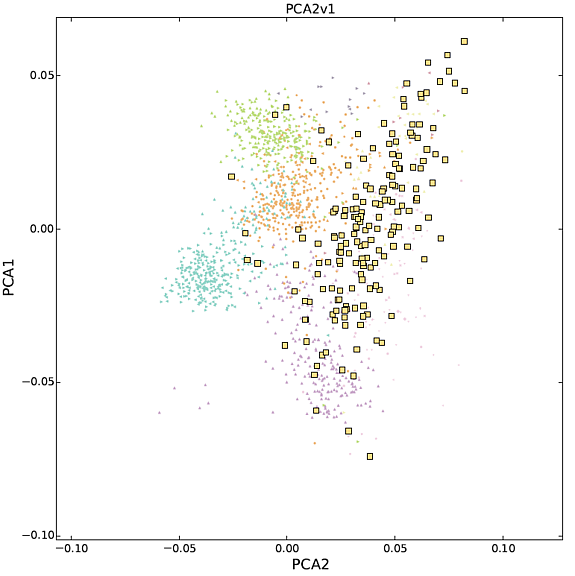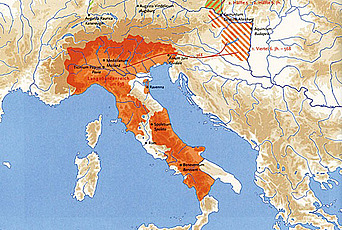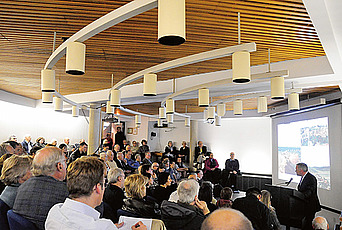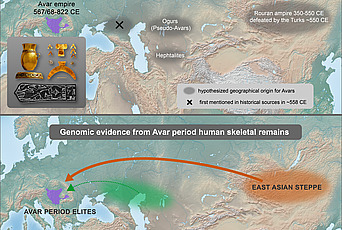Bridging the Two Culture Divide

The ability to recover and sequence DNA from ancient samples, known as the field of paleogenomics, has undergone major advances. These advances are not only revolutionizing the study of paleolithic hominids, the dispersal of populations across the globe, and knowledge of prehistoric population changes and migrations, but are also allowing scholars to answer questions about much more recent history, previously inaccessible using solely traditional historical and archaeological sources. Paleogenomics techniques allow scholars to put aside the broad-brush approach of the past and tackle the challenge of producing a nuanced historical account even—and especially—in areas with great social complexity and no written record.
To meet the challenge of producing such a fine-grained understanding of historical phenomena (and to realize the full potential of paleogenomics), scientists and humanists must learn to work in close collaboration in order to integrate genomic data, written sources, and archaeological material. An international, interdisciplinary team of geneticists, archaeologists, historians, and anthropologists—funded by the European Research Council and operating under the label HistoGenes—is working on the largest project of its type ever undertaken, combining ancient DNA analysis with archaeological and historical approaches.1 By developing new methods and practices, and using many working groups to analyze data from a wide variety of sub-regions, this interdisciplinary team is well-positioned to meet such a challenge.2 Three years into this seven-year project, exciting preliminary results are beginning to emerge.
Using Conventional Methods in Complex Regions
Most historically directed paleogenomic projects have consisted of transects—that is, studies that take ancient DNA samples from a wide variety of locations over centuries to understand broad-scale changes in human population demography. For recent periods, historians are skeptical of such broad-brush approaches that assume that a few samples from a location are representative of a whole population. Historians are also concerned when geneticists attempt to assign names of historically documented peoples to the clusters that emerge from these studies, and even more so when ideologues attempt to draw a direct line between these genetic clusters and contemporary populations. Too often, such studies have been carried out without detailed collaboration and consultation with historians and archaeologists, and rely on outdated nineteenth-century historical paradigms that assumed historically recorded “peoples” shared a common ancestry, language, and culture—controversially put, an essence—that clearly distinguished one from another and that could be traced from the moment of their appearance in the historical record to the present day.
All of these challenges are particularly acute in the study of the period from c. 400–900 C.E., when medieval Europe emerged after the dissolution of the Western Roman Empire in a process that involved migrations, demographic change, and the rise of post-Roman Christian kingdoms in the West and non-Roman “barbarian” societies in the East. One of the most complex regions affected by these changes was the Carpathian Basin, the area that stretches roughly from the Vienna Woods to Belgrade, where at least six different models of social and political organization coexisted, merged, or replaced each other. These included the Christian Roman Empire with its series of cities, forts, trade routes, and agricultural organization; barbarian militaries with their elites who replaced Roman governance and partially integrated into the Roman system; post-Roman rural populations that continued to live and work the land; Steppe warriors including the Huns and Avars whose empires relied on plunder and tribute from their neighbors as well as the agricultural produce of their farmers; radically decentralized Slavic groups who gradually built entirely new social and political structures; and finally, the expanding Frankish empire that conquered much of the region in the late eighth and ninth centuries.
The extraordinary complexity of this region across these centuries is difficult to assess because although they were identified by their neighbors with a bewildering list of names including Huns, Goths, Gepids, Heruls, Sciri, Suebians, Longobards, Bulgars, Avars, Slavs, and Byzantine captives, none of these populations, with the exception of a few Byzantine and Carolingian texts, left any written record. We do have extensive archaeological material, including some 70,000 well-excavated graves from the region, but these alone cannot tell us about population continuity, the make-up of newly arrived groups, social organization, and integration at the local or regional level, or how these men and women understood themselves and their world.
Methods to Meet the Challenges
The HistoGenes team is in the process of analyzing over 6,000 burials from dozens of cemeteries in the Carpathian Basin, capturing more than one million markers from across the genome from each of the individual burials, while subjecting each grave to detailed archaeological and osteological analysis. Unlike transect studies that sample numerous cemeteries, the team is sequencing, whenever possible, entire cemeteries in order to capture the entire diversity of even the smallest local populations. Then, they employ the methods of principle component analysis (PCA), admixture, and network analysis to sketch a thorough and nuanced understanding of a complex history.
When first looking at the genomic data produced, they perform a preliminary, unsupervised survey of the diversity of these communities using the technique of PCA, a statistical procedure that identifies patterns in a complex multidimensional data set. It does this by converting a set of possibly correlated variables into a set of those components that account for as much of the variance within the set as possible. Thus, the first component accounts for the greatest variance, the second for the second greatest, etc. In theory, any number of resulting components from PCA can be examined. However, in population genetics, PCA is typically used to create a visual representation of genetic distance and relationships separating populations by plotting the first and second principal components for each sample. The result is to show, via a two-dimensional image, the relative distance separating all of the samples.
Previous studies have shown that when PCA is applied to modern European individuals, the resulting two-dimensional image replicates, to a remarkable extent, a map of Europe, demonstrating that geographical distance is the strongest indicator of genetic identity (a phenomenon known as isolation-by-distance). Ancient samples can also be projected onto modern background PCA maps in order to visualize the diversity of the genetic backgrounds within an individual cemetery or group of cemeteries. A significant advance, moreover, has been that, as more and more penecontemporary ancient DNA samples become available, it is possible to dispense with these modern background PCA maps and place the populations with greater accuracy relative to the genetic diversity of Eurasia in late antiquity and the Early Middle Ages. The use of PCA, for example, has made it possible to demonstrate that in the late sixth to early seventh century, a considerable, rapid migration from central and eastern Asia into the Carpathian Basin took place. This confirmed the origins of the core of the Steppe nomadic Avars who ruled the region for over two centuries.3
The second method employed (this one supervised), admixture analysis, compares the relative percentages of genetic ancestry in individuals to representative “reference” populations from Europe, Asia, and Africa. The reference populations used for this analysis, taken from the 1000 Genomes Project, are of course nominal, since they are themselves composites—no individuals are ever pure anything. However, it can be helpful in a general comparative sense to see the relative ancestral composition of individuals buried at the sites under investigation.

Since HistoGenes works to sequence whole cemeteries, the project can also look at the biological relationships among individuals buried in the same cemetery or between nearby cemeteries. With modern DNA, this is a simple procedure; for ancient DNA, plagued as it is by low quality sequence data due to DNA degradation, this is problematic. A key member of the HistoGenes team, Krishna Veeramah of Stony Brook University, has developed a statistical tool that accounts for this uncertainty and accurately calculates the kinship coefficient that can infer relationships down to approximately fifth degree relatives (depending on the quality of the underlying data), that is, to third cousins.4 Using this tool, and in collaboration with archaeologists and anthropologists, the project can work out pedigrees, sometimes over as many as seven generations, and determine when, if at all, they begin to merge. Marriage strategies can also be recognized by determining the origins of spouses. By plotting the location of burials of closely related individuals within cemeteries, the project can also gain some insight into the importance of these biological ties within these local communities.
Finally, by examining long contiguous blocks of DNA that are transmitted across generations, the researchers can now start to infer more distant relationships between individuals from different sites and regions. Network analysis of these blocks, termed tracts of identity by descent, help to depict the regional social bonds and distant origins of the inhabitants of the region across centuries.
Findings and the Future
Thus far, these results are very preliminary. However, the enormous variation within this region can already be seen, not only at the macro level, but even within small areas of a few square miles and within a half century. In some cases, the genetic diversity within Europe. Clearly, this is a complex society. However, this does not mean that all of these groups intermarried rapidly. In some nearby cemeteries where the material culture suggests a homogeneous population, one community with a marked Asian ancestry continued for generations to choose wives from other more distant communities with a similar ancestry while avoiding marriage with their nearby, more-western neighbors.
Other cultural practices were also identified, such as evidence of levirate marriages—the custom found in various societies in which the widow of a man is remarried to one of his close kin, a brother, uncle, or even her own step son. This practice, which serves both as a way of keeping property given to a bride at marriage within the husband’s kindred and of supporting a widow, is still followed in Steppe societies of Central Asia, and suggests that in the Avar empire certain Steppe cultural traditions survived for generations.
During the remaining four years of the project, the HistoGenes team expects to complete these regional studies and to establish connections among them and with other, more distant populations, thereby creating a dynamic image of the relationship between biology, culture, and mobility in this region. Ultimately, this is made possible by bringing humanists and scientists together as equal partners in a common endeavor, offering a model for both future collaborations and the future of understanding humanity in all its complexity.
Patrick J. Geary is Professor Emeritus in the School of Historical Studies, Distinguished Professor Emeritus at UCLA and former President of the Medieval Academy of America. He has written widely on western European social and cultural history in the first millennium, on the history of memory, language, and gender, as well as ethnicity, identity, and the misuse of the past by contemporary ideologues. He is co-Principal Investigator of HistoGenes.
- The principal investigators include Walter Pohl of the Austrian Academy of Sciences; Tivadar Vida, head of the Institute for Archaeological Sciences at the Eötvös Loránd University in Budapest; Johannes Krause, Director of the Max Planck Institute for Evolutionary Anthropology in Leipzig; and at the Institute for Advanced Study, Patrick Geary, Professor Emeritus in the School of Historical Studies. Further collaborators include scholars and scientists from Austria, Hungary, the U.S., Romania, Serbia, Slovenia, Slovakia, the Czech Republic, and Germany. This project is funded by the European Research Council (ERC) under the European Union’s Horizon 2020 research and innovation programme (grant agreement n° 856453 ERC-2019-SyG).
- The HistoGenes team has formed working groups to analyze data from sub-regions including eastern Austria around present-day Vienna; the Little Hungarian Plain in northwest Hungary and southern Czechia, the western end of the Lake Balaton, the complex post-Roman settlement around the Roman site Keszthely, two large seventh-century cemeteries at Rákóczifalva in central Hungary, and a complex of sites in present-day Slovenia that extend from the fourth to the tenth centuries, among others.
- Guido Alberto Gnecchi-Ruscone et. al. “Ancient genomes reveal origin and rapid trans-Eurasian migration of 7th century Avar elites,” Cell, vol 185 (2022): 1-12. https://doi.org/10.1016/j.cell.2022.03.007
- M. Lipatov, K. Sanjeev, R. Patro, K. R. Veeramah, Maximum Likelihood Estimation of Biological Relatedness from Low Coverage Sequencing Data. bioRxiv, 023374 (2015).


